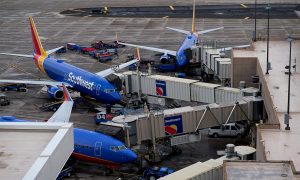When USA Today’s Business Travel Correspondent Charisse Jones moved onto the travel beat about 4 years ago, she didn’t know what to expect. She had spent her entire career as a hard news reporter at the Los Angeles Times, covering issues on social justice and even had her share of L.A. riots coverage which won her a Pulitzer Prize.
Before joining USA Today, Jones worked for the New York Times, NPR and Essence Magazine. She is also co-author of the book “Shifting, The Double Lives of Black Women in America.” Travel reporting was brand new territory to Jones when USA Today switched her beat form News to the Money section as an effort to fill in empty staff positions in the paper. Now, she’s developed a breadth of knowledge with news and trends in the travel and aviation industry.
Jones said she had always enjoyed being a “generalist” in her reporting because she thought she would never get bored, but her new beat proved o be multifaceted and complex. She also soon realized that business travel is a rapidly evolving industry, which means good stories spanning a wide range of topics are always available.
Jones has written about hotels and their new amenities, how the industry could see a pilot shortage, how to find the cheapest airfare, how travelers are dealing with their fear of flying, and how airports are offering more healthy eating options.
When crafting stories, Jones says she always thinks about what matters most to the reader both as a consumer and passenger. And whether it’s by eliminating jargon or personalizing topics, Jones finds ways to make her stories more accessible to the general public.
She tries to speak to real travelers for just about every one of her stories, looking at an issue from their perspective, hearing about their experiences and what concerns them.
Jones talks about how to immerse yourself in the travel and airline beat and explains why you should pay attention to Delta’s revamped 30-year-old loyalty program, which will now give travelers flier miles based on the cost of their ticket, rather than the number of miles flown.
1. How should a reporter new to the travel/airline beat start learning about the industry?
That’s a great question, because I’ll tell ya, I’m still learning. There are just so many layers. For one thing, American Airlines actually has a glossary of terms that you can look up. You’ll get this whole list that explains to you what these different things mean: What is a “seat mile?” What is “PRASM” and “RASM?” There’s all of this stuff they [airlines] discuss whenever they do their earnings calls, etcetera, and they have it all spelled out for you. So that’s a real basic cheat sheet that you might want to print out and put on your desk.
There’s an expert for everything. There’s an analyst that can talk to you about frequent flyer miles. There’s somebody else who’s a specialist in the Dreamliner (Boeing’s 787). There’s somebody else who’s a specialist in fuel conservation. And if you read other people’s stories, you’re going to usually see these people quoted at some point. When you see that, write them down and when you’re doing the story, these are the people you can call out to. They’ll just walk you through it. I’ll sometimes just ask a very basic question, and even though I think I already know the answer, I just want to have that reiterated to me, to make sure that I’m not mixing things up. And over time, you’re going to become more of an expert. You’re going to become more comfortable. You’re not always going to have to repeat the same questions, but initially, I think that’s a really good way to do it. Talk to the experts and get those terms.
2. Are there any essential sources that travel reporters should use? Such as social media accounts or any official websites?
I think Twitter is a great resource for everything. All of the airlines have Twitter handles. Sometimes it will be through Twitter that you’ll find out there was an incident involving turbulence, and the plane is turned around. You might get it from Twitter before you get it form CNN or from the airlines.

There are also a lot of trade groups. A4A, Airlines for America is the trade group for the U.S. carriers, and so they’re not always releasing information up front, [but] they’re a great resource. You know, sometimes you’ll have a question and the airlines don’t want to be the only one to comment on it or they won’t comment at all. It’s a good idea to be able to call them to get a broader industry perspective.
Another organization you want to get on the email list for is IATA, International Air Transport Association. They’re the A4A for the world. They monitor flying the airline industry globally, so they’re great in terms of getting the global traffic numbers: Are fewer people traveling internationally or not? What’s the revenue outlook look like? And they usually put out periodic papers, email blasts that have a lot of really interesting information, that even if you don’t write about it for a story that day, it can inform your reporting for the rest of that year.
Boeing is also a resource, because they make the airplanes and they put out a lot of reports.
3. Are there differences when writing stories for the leisure traveler versus the business traveler? If so, what types of stories cater to one over the other?
I think that there is a difference. The business traveler is somebody that is flying more frequently, they’re a little bit more knowledgeable about the industry. They tend to, for example, kind of go crazy about the frequent flier loyalty programs, because usually they belong to them, and they have status within the program. And so they’re very concerned about that type of thing. The leisure traveler, they’re probably someone that needs to be educated more about when the fare sale happens. Business travelers are on expense account. They’re not having to pay for their own ticket, but the leisure traveler is. So that’s something that they worry about. They need to know what days to fly during the week. How far in advance do you book your ticket? They need to know about what they’re going to get charged extra for.
Those are some of the differences in what you’re writing about, but I think both groups benefit from knowing how the industry is transforming through the mergers. Low cost carriers now are getting more entree into some airports they weren’t in because of the merger. So now Jet Blue and Southwest, that’s a bigger option for you if you live in D.C., or if you’re in New York and you want go out of Newark, you can now take Virgin America. So in the scheme of things, I think both groups have a similar interest, but there are some distinctions.
4. Are there any hot topics or trends you see emerging that you think reporters should be looking out for?
I think they need to really watch the loyalty programs. Now that Delta has made this (loyalty program) change, I think it’s only a matter of time before American and United follow. It’s a pretty significant change when it’s based off of how much you pay for the ticket and not how far you fly. That’s pretty seismic. Even though the low-cost carriers were already doing it that way.
I think that if you live in smaller cities, which is most of America, airlines are cutting back on smaller jets, they’re not flying them as frequently and they’re really streamlining now that they’ve consolidated, they’ve joined with other airlines. You need to watch the service, that’s a big story: what kind of fares are you paying if you’re in a small town [near] Milwaukee, are people having to drive more to get to the big airports in the bigger cities so that they can pay less.
The economy is getting better, but it’s still struggling. And even though fares are lower now than they were in the 1980s, it’s getting a little more expensive to fly, and I do wonder if it’s going to become something that not everybody can do. If more people are going to have to find that bus ticket or drive.
5. What advice do you have for reporters covering a large, long-term, multifaceted topic like the American-US Airways merger?
I think it’s important to give it breathing room. Dip back in from time to time. Initially when it was happening, there was a lot of just daily news you had to cover. So that was just breaking news. But now that it’s actually happened, you have to recognize that it’s going to take a while to unspool, and instead of kind of writing the same thing every day, it’s kind of smarter to pick your target. Now we’re six months in, what are some of the changes? Again, always thinking about the consumer. What are the things that a real person can see? Now they’ve combined terminals at this many airports, now if you’re a frequent flier, you’re recognized by both airlines. Those kinds of milestones. I think that’s kind of a better way, because if you’re kind of writing the same thing everyday and nothing is changing, people kind of tune out. And so it’s a way to kind of take it in bites.
These mergers take a really long time to happen. United and Continental are still having some synergy issues, and they merged back in 2010. You have to look at it as a long-haul thing: let me check in and out, and see what’s happening, and kind of look if there’s any fresh angle that you can bring to it. Try and sit and brainstorm to come up with that to stand out from the crowd a little bit.











